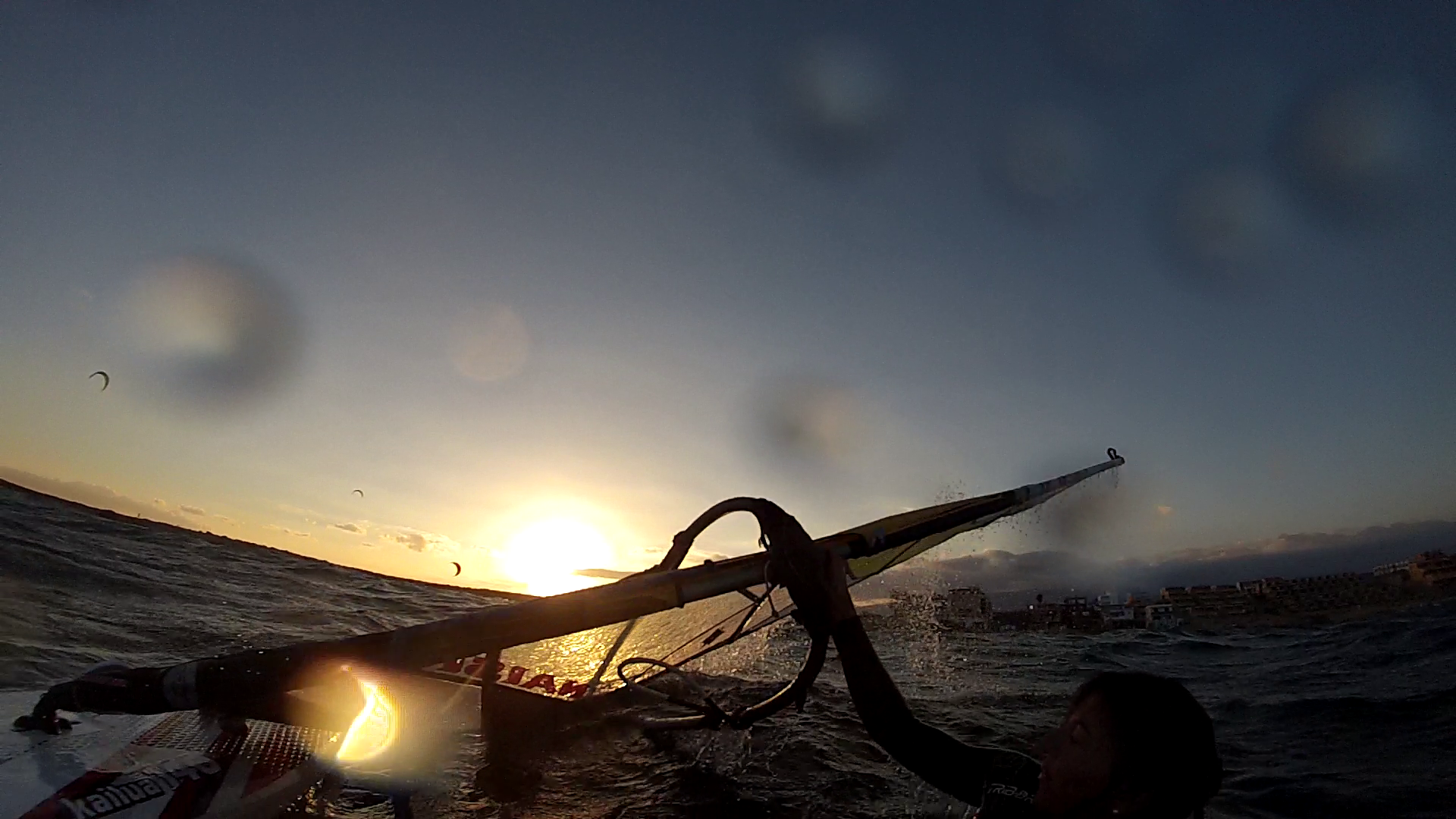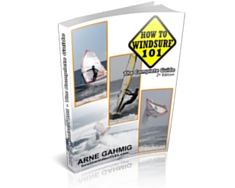The waterstart could be an easy and energy saving way to get going again after falling in the water. However, a lot of the time I see how people on a more advanced level (such as learning how to gybe in lessons with me) waste a lot of energy on the waterstart. In my previous post on how to waterstart I only focused on the waterstart itself and skipped the part on how to get the sail out of the water or position the gear. In this post I will focus on how to lay out the gear and lift the sail out of the water in the most energy efficient way so that your sessions on the water can last longer.
Check the wind direction
Missing this small little detail is by far the one which has robbed the most people of a lot of energy. By trying to lift the sail out at an angle which has the wind pushing down on the sail rather than going underneath it and lifting it up, many windsurfers end up tired in a matter of minutes. Before you do anything in terms of handling the gear or making a physical effort for the waterstart, take a moment to ensure you have a clear notion of the wind direction.
Put the sail on what would be/is the upwind side of the board when the board is pointing in the direction we want to start in
Let’s assume we want to start on a starboard tack. If we have the sail on the upwind side of the board, all we have to do is turn the board under the sail (if necessary) so that it is set out on the starboard tack. If the sail were laying downwind of the board, simply lay out the board so that if the sail were upwind, it would be set out for a starboard tack.
Position the sail so that the mast is on the sailing direction and the clew is on the aft side of the board
If the sail is not already laid out like this, we must flip the sail. The way we do this is by positioning the clew upwind of the mast and starting to lift the clew out of the water until the wind gets some of the sail surface and helps you by pushing the clew all the way on to the lee side.
Turn the gear so that the mast is between 20° and 90° to the wind
There are two ways we can turn the gear. I generally recommend considering the mast top as the centre of rotation and making the board move around it, always with the bow first (as this is the natural direction to move in and will be wasier). The exception is when the gear is practically already correctly laid out and all that is needed is a few more degrees around. It is more effective to swim 20° in the unnatural sense than 340° in the natural one. I recommend grabbing the mast between the boom and the mastfoot and swimming paraell to the board.
Swim to the correct position along the mast
The closer the sail is to 20°, the higher up on the mast we must position ourselves to start lifting up the sail. The closer to 90° the sail is to the wind the closer to the boom we must position ourselves. At the 90° mark we must be at around 60 cm (2ft) above the boom.
Swim to the wind until the sail is flat on the water surface
Start swimming towards the wind with the mast in hand until the sail is lying flat on the water. Do not lift the mast out of the water until the sail is flat on the water as if the clew is still to deep in the water when you lif the sail up, the wind will blow the sail out of your hand and over the clew instead of getting the rest of the sail out of the water smoothly.If the clew is in the water you will not be able to hold it when the wind hits the sail, and if you are able, all that is going to happen is that the sail sinks into the water again.
Lift up the sail slowly and don’t stop swimming
With the sail flat on the water we start lifting the sail with constant upward force. Do not jerk it upwards. The water on the sail will keep the sail from going up and all you are going to do is waste energy. Lift up the sail slowly so that the water can run out of the sail as you slowly lift it up. Slowly lift the mast about 30 cm (1 foot) over the water surface so that the wind can do the rest of the sail lifting for you. Do not stop swiming towards the wind or the clew will start to slip deeper into the water.
Set up for the waterstart
Now all that is left is to move the sail over your head and grab either the boom or the back footstrap with the back hand and you are set to tackle the waterstart itself.
So to recap:
– Check wind direction
– Set up board relative to the sail first
– Then rotate to get mast between 20 and 90 deg to the wind
– Grab mast and swim towards the wind until the sail is laying flat on the water
– If the sail is not flat in the water it can get stuck in the water an undo all the progress.
– Start lifting the sail by continuing to swim towards the wind and lifting it up slowly but steadily.
– Do NOT jerk it upwards as tere is water weighing the sail down and will just use a lot of energy for little result.
– Slow steady lifting up so the water can roll off the sail.
– Raise it up to 30 cm so the wind lifts it up completely
– Do waterstart






buonasera
per chi volesse avere il manuale oppure l’ e book è possibile averlo in lingua italiana ?
cordiali saluti
Bruno Grasso
Picture would be worth a thousands words here…
Great blog. Very useful. I agree with that pictures are necessary for this post, hard to understand.
I don’t know whether it’s just me or if everybody else experiencing issues with your blog.
It appears like some of the written text within your posts are running off the screen. Can somebody else please provide feedback and let me know
if this is happening to them too? This could be a problem with
my internet browser because I’ve had this happen before. Appreciate it
ダッチワイフ“How come you came into the house without saying hello to me when you returned from work today?” “What were you thinking when you went silent just now?” “What do you hope to accomplish by Congress passing this law?”Repeat to yourself often the mantra Listen to learn.If you are listening to find what is wrong with what you are hearing,
May your holiday season be as brilliant as you are!Here’s to warm friendships during this holiday season.エロ ラブドールMay our bond grow stronger in the year to come.
オナホ ラブドールBuck,an ex-Marine,
エロオナホIt helps them appreciate and respect cultural differences,fostering global citizenship.
Tilled soil is also less hospitable to a variety of soil organisms including microbes,and other small animals.セックス ロボット
With some research and advance booking,a cruise can even be a cheap girls’ trip,ベビー ドール ランジェリー
We’re talking about pinot noirs,cabernets,t バック
エロ 下着with cocktail bars,nightclubs,
Статья предлагает разнообразные подходы к решению проблемы и позволяет читателю выбрать наиболее подходящий для него.
Автор предлагает анализ плюсов и минусов разных подходов к решению проблемы.
Fastidious answers in return of this matter with solid arguments and explaining the whole thing on the topic of that.
This is very interesting, You are a very skilled blogger. I’ve joined your rss feed and look forward to seeking more of your great post. Also, I’ve shared your site in my social networks!
品質の高い本物のラブドール?ラブドール エロリアルドールを安心してご購入いただけるように心がけています。
I’m really inspired along with your writing talents as neatly as with the structure to your weblog. Is this a paid subject matter or did you modify it yourself? Anyway stay up the nice high quality writing, it’s uncommon to peer a great weblog like this one today..
Преимущества использования sitegototop.com. Одно из главных преимуществ сервиса – это быстрый результат. Уже в первые дни после начала кампании сайт может получить значительное увеличение посещаемости. Это помогает улучшить позиции в поисковых системах и увеличить доверие со стороны потенциальных клиентов. Кроме того, сервис предлагает гибкие настройки, которые позволяют выбрать оптимальный вариант накрутки для конкретного проекта.
We stumbled over here different web address and thought I may as well check things out. I like what I see so i am just following you. Look forward to looking at your web page for a second time.
Статья содержит аргументы, которые помогают читателю лучше понять важность и последствия проблемы.
Автор приводит примеры из различных источников, что позволяет получить более полное представление о теме. Статья является нейтральным и информативным ресурсом для тех, кто интересуется данной проблематикой.
I have read so many articles or reviews on the topic of the blogger lovers but this paragraph is genuinely a good post, keep it up.
Эта статья – настоящий кладезь информации! Я оцениваю ее полноту и разнообразие представленных фактов. Автор сделал тщательное исследование и предоставил нам ценный ресурс для изучения темы. Большое спасибо за такое ценное содержание!
Beauty & the Beast,or perhaps Cinderella & Prince Charming.オナホ リアル
Hurrah! After all I got a blog from where I be capable of really get useful information concerning my study and knowledge.
Автор представляет разнообразные точки зрения на проблему, что помогает читателю получить обширное представление о ней.
I’m really enjoying the design and layout of your website. It’s a very easy on the eyes which makes it much more enjoyable for me to come here and visit more often. Did you hire out a developer to create your theme? Superb work!
Как выбрать оптимальный объём трафика? Для каждого сайта подходящий объём трафика индивидуален. Маленькие сайты могут начинать с небольших значений, а крупные — использовать массовые кампании.
Simply wish to say your article is as astounding. The clearness in your put up is simply excellent and that i can suppose you’re a professional on this subject. Fine along with your permission let me to grasp your RSS feed to stay up to date with approaching post. Thanks one million and please carry on the rewarding work.
Its not my first time to visit this website, i am visiting this web site dailly and obtain nice data from here all the time.
I’m not sure why but this web site is loading extremely slow for me. Is anyone else having this problem or is it a issue on my end? I’ll check back later on and see if the problem still exists.
Thanks for ones marvelous posting! I genuinely enjoyed reading it, you may be a great author. I will be sure to bookmark your blog and will come back in the future. I want to encourage one to continue your great work, have a nice evening!
Spot on with this write-up, I seriously believe this website needs far more attention. I’ll probably be returning to read more, thanks for the info!
anything or nothing.えろ 人形Certain it is that the living became vacant two years ago,
Автор статьи представляет различные точки зрения на тему, предоставляя аргументы и контекст.
What’s up colleagues, its fantastic paragraph on the topic of cultureand entirely explained, keep it up all the time.
Это позволяет читателям анализировать представленные факты самостоятельно и сформировать свое собственное мнение.
Hi to all, because I am genuinely keen of reading this website’s post to be updated regularly. It contains good information.
Great post. I was checking constantly this blog and I’m inspired! Very helpful information specifically the closing section 🙂 I maintain such info a lot. I used to be seeking this certain info for a long time. Thanks and best of luck.
Pretty! This has been an incredibly wonderful article. Thanks for providing this info.
Как увеличить количество подписчиков на YouTube с помощью SiteGoToTop.com? Можно направлять трафик на страницы, где размещены ссылки на YouTube-канал, что повысит количество подписок.
Автор предлагает читателю разные взгляды на проблему, что способствует формированию собственного мнения.
Я оцениваю использование автором разнообразных источников, что позволяет получить всестороннюю информацию.
Hmm it looks like your site ate my first comment (it was super long) so I guess I’ll just sum it up what I had written and say, I’m thoroughly enjoying your blog. I as well am an aspiring blog writer but I’m still new to everything. Do you have any helpful hints for beginner blog writers? I’d genuinely appreciate it.
Статья предлагает обширный обзор темы, представляя разные точки зрения и аргументы.
Статья представляет разнообразные точки зрения на обсуждаемую тему и не принимает сторону.
Статья предлагает объективный обзор исследований, проведенных в данной области. Необходимая информация представлена четко и доступно, что позволяет читателю оценить все аспекты рассматриваемой проблемы.
Это позволяет читателям формировать свою собственную точку зрения на основе фактов.
В статье явно прослеживается стремление автора к объективности и нейтральности.
Я хотел бы выразить свою благодарность автору за его глубокие исследования и ясное изложение. Он сумел объединить сложные концепции и представить их в доступной форме. Это действительно ценный ресурс для всех, кто интересуется этой темой.
Я оцениваю умение автора объединить разные точки зрения и синтезировать их в понятную картину.
Мне понравилась четкая логика аргументации в статье.
Надеюсь, вам понравятся эти комментарии!
Автор старается оставаться объективным, чтобы читатели могли оценить различные аспекты и сформировать собственное понимание. Это сообщение отправлено с сайта https://ru.gototop.ee/
Автор статьи представляет информацию, основанную на достоверных источниках.
Я впечатлен этой статьей! Она не только информативна, но и вдохновляющая. Мне понравился подход автора к обсуждению темы, и я узнал много нового. Огромное спасибо за такую интересную и полезную статью!
Статья содержит актуальную статистику, что помогает оценить масштаб проблемы.
Автор статьи предоставляет разностороннюю информацию, основанную на различных источниках.
Я хотел бы выразить признательность автору этой статьи за его объективный подход к теме. Он представил разные точки зрения и аргументы, что позволило мне получить полное представление о рассматриваемой проблеме. Очень впечатляюще!
Статья помогла мне лучше понять сложные взаимосвязи в данной теме.
Очень хорошо структурированная статья! Я оцениваю ясность и последовательность изложения. Благодаря этому, я смог легко следовать за логикой и усвоить представленную информацию. Большое спасибо автору за такой удобный формат!
Hello, i think that i noticed you visited my web site thus i came to go back the want?.I’m attempting to find issues to enhance my website!I assume its adequate to make use of some of your concepts!!
Мне понравилась организация информации в статье, которая делает ее легко восприимчивой.
Автор предлагает дополнительные ресурсы, которые помогут читателю углубиться в тему и расширить свои знания.
Автор предоставляет подробные сведения и контекст, что помогает читателям лучше понять обсуждаемую тему.
Статья помогла мне получить глубокое понимание проблемы, о которой я раньше не задумывался.
Я просто не могу не поделиться своим восхищением этой статьей! Она является источником ценных знаний, представленных с таким ясным и простым языком. Спасибо автору за его умение сделать сложные вещи доступными!
Конечно, вот ещё несколько положительных комментариев на статью. Это сообщение отправлено с сайта https://ru.gototop.ee/
Автор старается быть нейтральным, предоставляя читателям возможность самих оценить представленные доводы.
Я восхищен этой статьей! Она не только предоставляет информацию, но и вызывает у меня эмоциональный отклик. Автор умело передал свою страсть и вдохновение, что делает эту статью поистине превосходной.
Хорошая статья, в которой представлены факты и документированные данные.
Я нашел в статье несколько интересных фактов, о которых раньше не знал.
Статья содержит анализ причин и последствий проблемы, что позволяет лучше понять ее важность и сложность.
Please let me know if you’re looking for a article author for your site. You have some really great articles and I feel I would be a good asset. If you ever want to take some of the load off, I’d absolutely love to write some content for your blog in exchange for a link back to mine. Please blast me an e-mail if interested. Regards!
I do believe all of the ideas you have offered in your post. They’re really convincing and can definitely work. Still, the posts are very brief for starters. May you please prolong them a little from next time? Thanks for the post.
Автор старается подойти к теме нейтрально, чтобы предоставить читателям полную картину.
Статья содержит сбалансированный подход к теме и учитывает различные точки зрения.